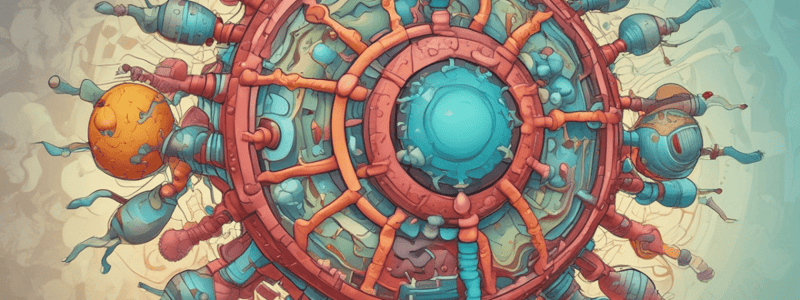Podcast
Questions and Answers
What is the characteristic of Reovirus?
What is the characteristic of Reovirus?
What is the primary site of Rotavirus infection?
What is the primary site of Rotavirus infection?
What is the main complication of Rotavirus infection?
What is the main complication of Rotavirus infection?
What is the mechanism of Rotavirus-induced diarrhea?
What is the mechanism of Rotavirus-induced diarrhea?
Signup and view all the answers
What is the recommended timing for the first dose of Rotavirus vaccine?
What is the recommended timing for the first dose of Rotavirus vaccine?
Signup and view all the answers
What is the population most at risk for Rotavirus infection?
What is the population most at risk for Rotavirus infection?
Signup and view all the answers
What is the typical duration of Rotavirus infection?
What is the typical duration of Rotavirus infection?
Signup and view all the answers
What is the primary treatment for Rotavirus infection?
What is the primary treatment for Rotavirus infection?
Signup and view all the answers
What is unique about the genetic material of Reovirus?
What is unique about the genetic material of Reovirus?
Signup and view all the answers
What is the function of NSP4 in Rotavirus infection?
What is the function of NSP4 in Rotavirus infection?
Signup and view all the answers
What is the structure of the Rotavirus capsid?
What is the structure of the Rotavirus capsid?
Signup and view all the answers
What is the result of enterocyte damage in Rotavirus infection?
What is the result of enterocyte damage in Rotavirus infection?
Signup and view all the answers
What is the significance of the boat name 'CHLO-RIDER' in the context of Rotavirus?
What is the significance of the boat name 'CHLO-RIDER' in the context of Rotavirus?
Signup and view all the answers
What is the characteristic of Rotavirus outbreaks?
What is the characteristic of Rotavirus outbreaks?
Signup and view all the answers
What is the result of Rotavirus infection on the small intestine?
What is the result of Rotavirus infection on the small intestine?
Signup and view all the answers
Why is the Rotavirus vaccine typically administered orally?
Why is the Rotavirus vaccine typically administered orally?
Signup and view all the answers
Study Notes
Reovirus and Rotavirus
- Reovirus has 11 segments of double-stranded RNA.
- Rotavirus replicates in the cytoplasm and has a naked capsid with 3 layers.
- Rotavirus is a double-stranded RNA virus with 11 segments.
Rotavirus Infection
- Rotavirus infects enterocytes in the villi of the small intestine.
- Damaged enterocytes release the virus into the lumen.
- Infection is usually self-limiting and resolves in 3-7 days.
Clinical Features
- Rotavirus causes toxic-mediated secretory diarrhea.
- NSP4 causes secretory diarrhea.
- Chloride permeability is increased, leading to diarrhea.
Epidemiology
- Rotavirus is a major etiology of infantile gastroenteritis worldwide.
- Children are the population most at risk, especially those in daycare.
Prevention and Treatment
- Treatment is supportive care and oral rehydration therapy.
- Live attenuated oral vaccine is available.
- The first dose should be given before 3 months of age to ensure efficacy and reduce the risk of intussusception.
Reovirus and Rotavirus
- Reovirus has 11 segments of double-stranded RNA.
- Rotavirus replicates in the cytoplasm and has a naked capsid with 3 layers.
- Rotavirus is a double-stranded RNA virus with 11 segments.
Rotavirus Infection
- Rotavirus infects enterocytes in the villi of the small intestine.
- Damaged enterocytes release the virus into the lumen.
- Infection is usually self-limiting and resolves in 3-7 days.
Clinical Features
- Rotavirus causes toxic-mediated secretory diarrhea.
- NSP4 causes secretory diarrhea.
- Chloride permeability is increased, leading to diarrhea.
Epidemiology
- Rotavirus is a major etiology of infantile gastroenteritis worldwide.
- Children are the population most at risk, especially those in daycare.
Prevention and Treatment
- Treatment is supportive care and oral rehydration therapy.
- Live attenuated oral vaccine is available.
- The first dose should be given before 3 months of age to ensure efficacy and reduce the risk of intussusception.
Studying That Suits You
Use AI to generate personalized quizzes and flashcards to suit your learning preferences.
Description
This quiz covers the structure and replication of Rotavirus and Reovirus, as well as the clinical features of Rotavirus infection. Learn about the characteristics of these viruses and how they infect the small intestine.



